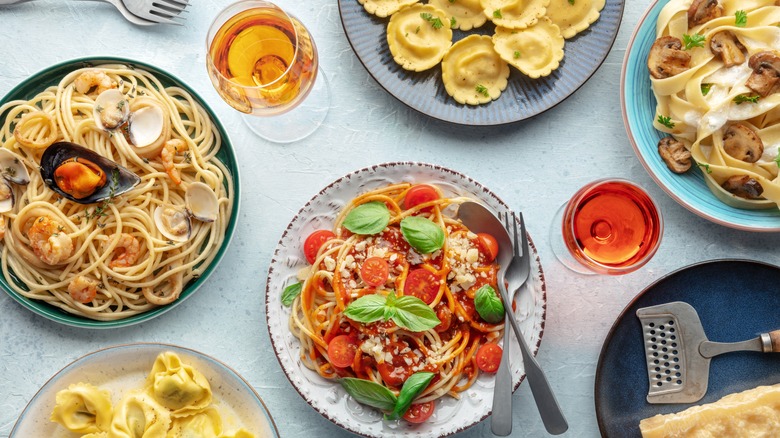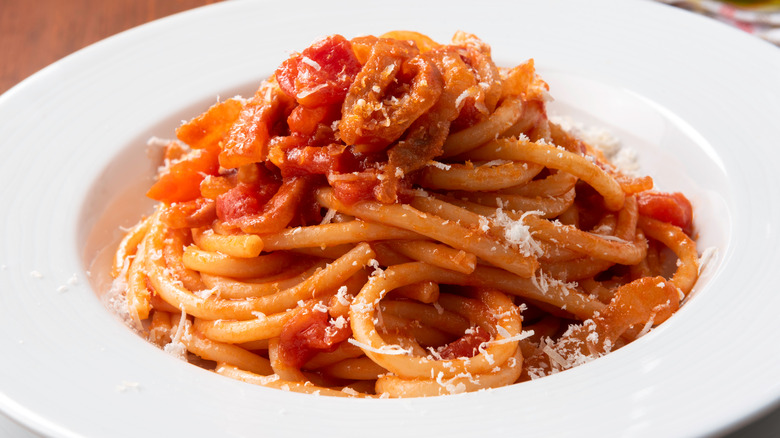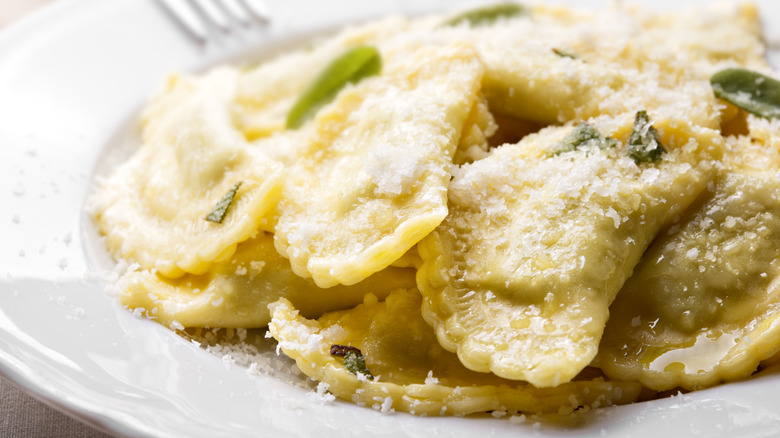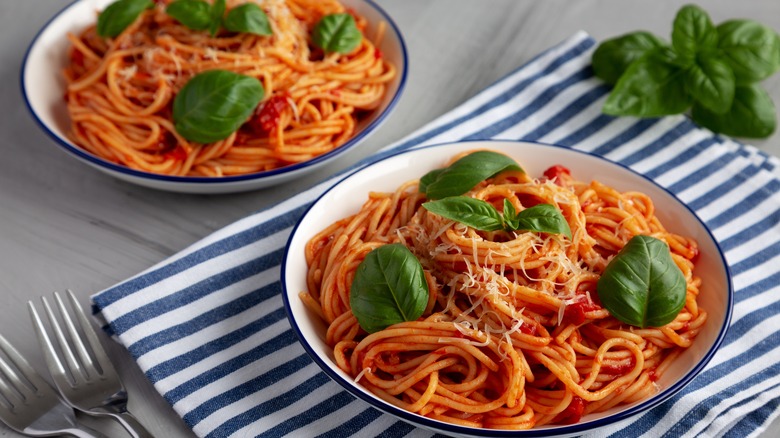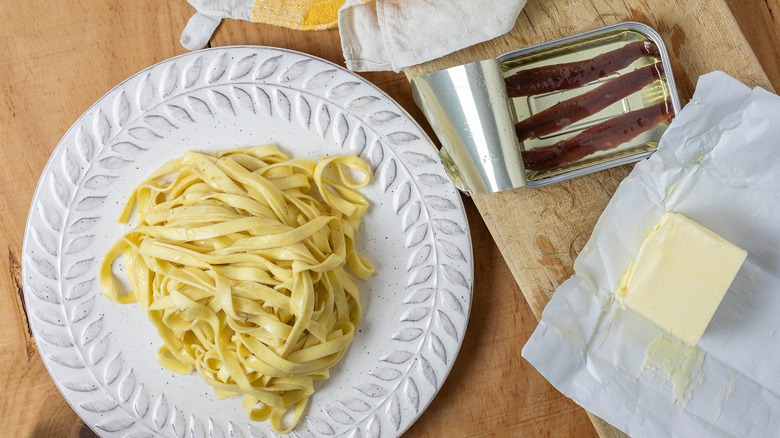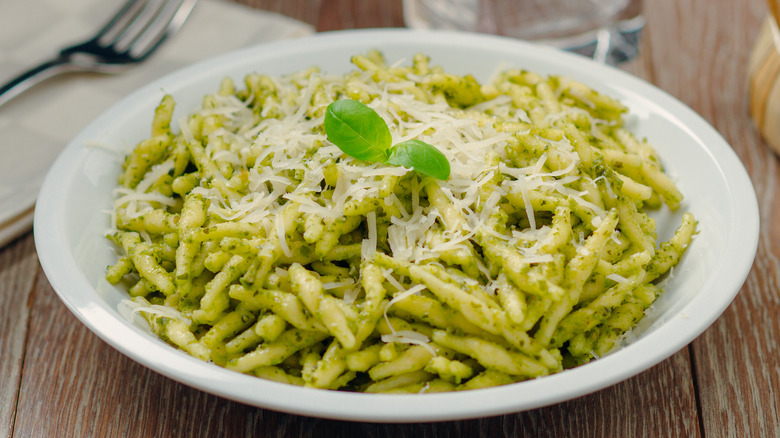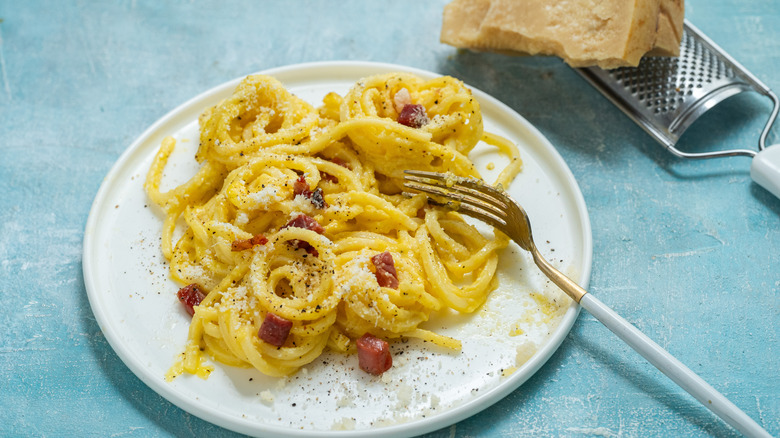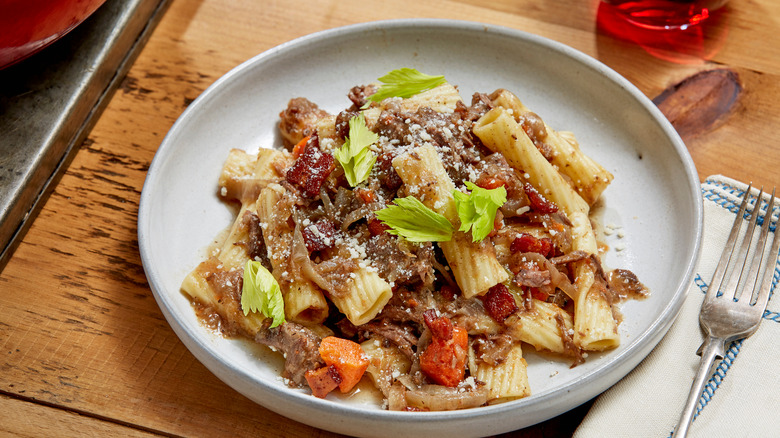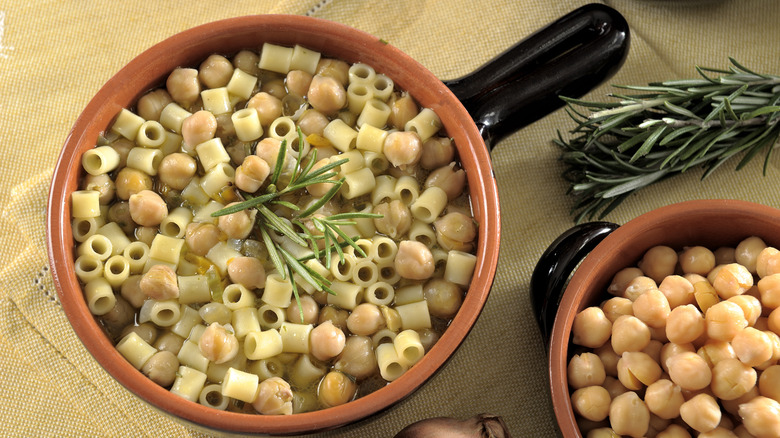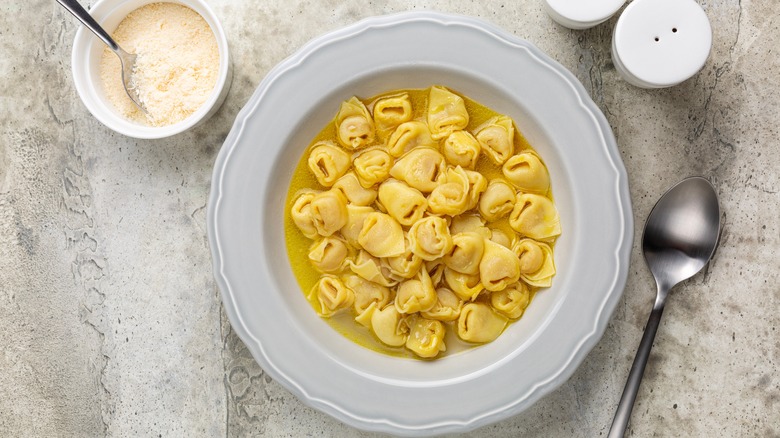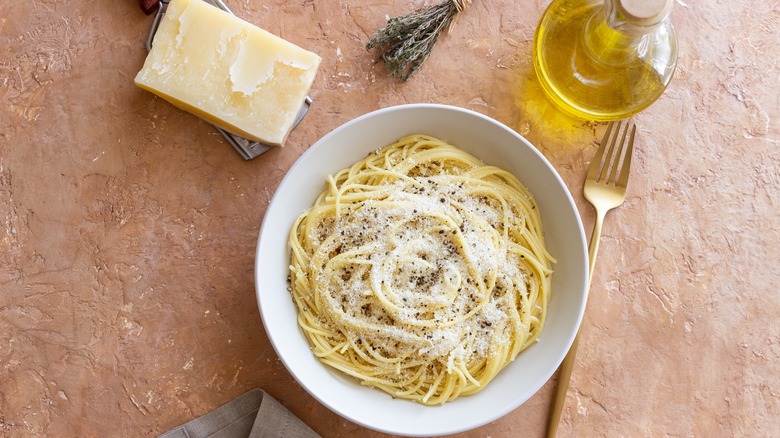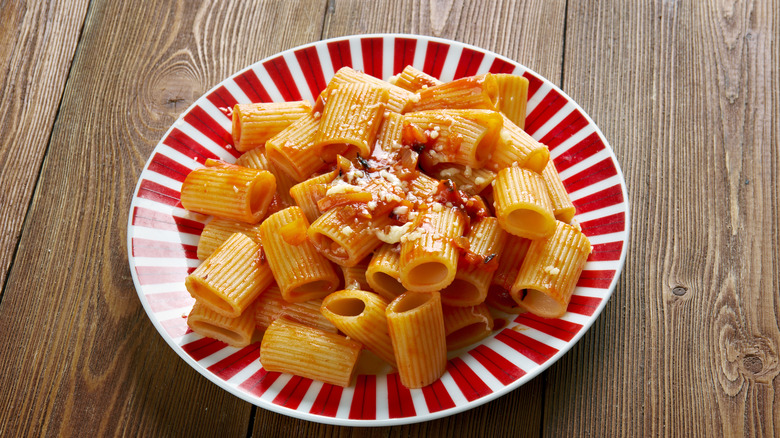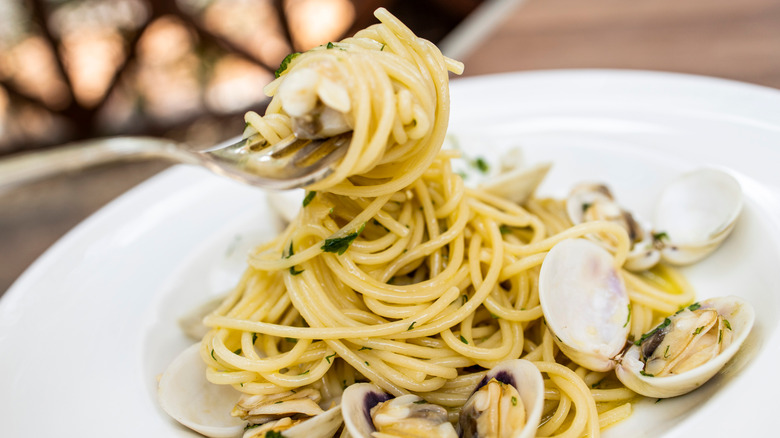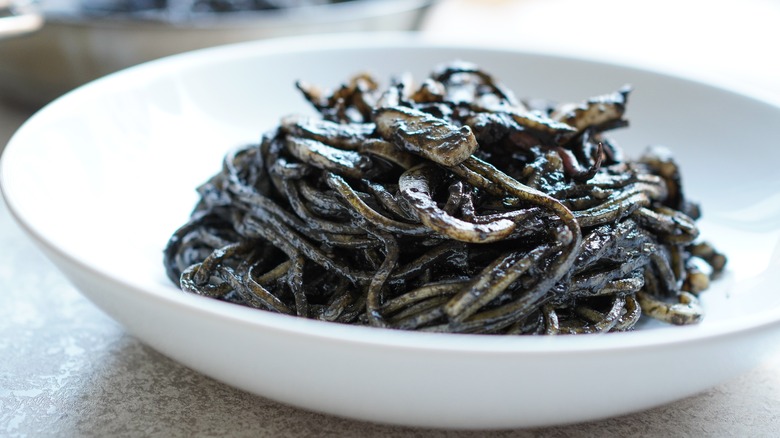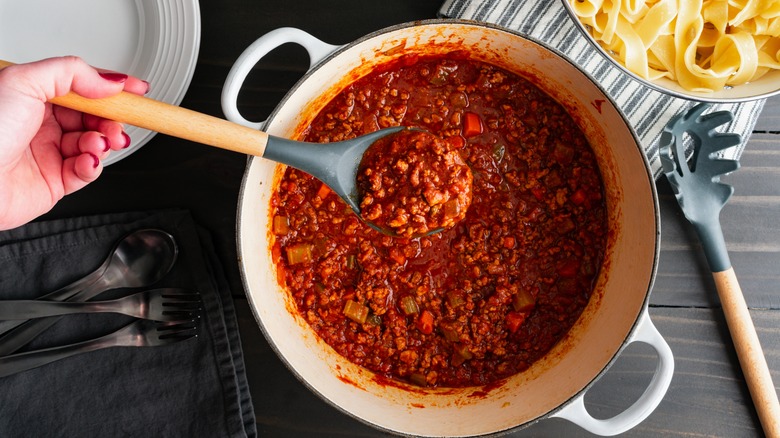14 Must-Try Italian Pasta Sauces You'll Wish You Tried Sooner
Pasta is the star of Italian cuisine. The country features more than 350 pasta shapes, and while some are strictly regional, spaghetti, rigatoni, or penne are internationally known and adored. But the pasta foundation can't stand alone and always calls for a saucy coating — and these accompanying sauces are equally plentiful. Many are region-specific, but there are numerous sauces that have long been familiar beyond Italian borders. Of course, only some of these can fall into the must-try category, and we wanted to see which would classify as such.
To make a fully trustworthy list, we consulted with experts on Italian food. We interviewed Sophie Minchilli, a tour guide and a book author who leads food tours in Rome and knows how Italians live and eat. We referred to Katy Clarke, the founder of Untold Italy, to provide valuable first-hand info as she specializes in food and wine experiences in Italy, and we asked Danielle Oteri, a writer and the person behind Feast Travel, to offer her insight on this food-centered topic. Together, we built this lineup that you can use as a reliable guide.
1. Amatriciana
The list of essential Italian pasta sauces can't be complete without mentioning Amatriciana, one of the quintessential Roman pasta dishes, and an all-time favorite for Sophie Minchilli. Like many other pasta sauces, Amatriciana's origin is vague, though it most likely hails from Amatrice, a small town in the province of Rieti, Lazio. There are many theories about its origin, but the most popular says that it is an extension of the white gricia, which also belongs to the group of classic Roman pasta sauces. Gricia is one of the simplest combinations, initially made by local shepherds who tossed pasta in the rendered guanciale (pork jowl) and grated cheese. In Amatrice, the sauce was adapted with the addition of tomatoes to create the contemporary version we know today.
Minchilli explains that the exact ingredients are controversial, but you can't go wrong with canned peeled tomatoes, guanciale, and pecorino. She adds: "No olive oil because of the fat released from the guanciale, and definitely no onions or garlic!" Minchilli shares that this is what she craves the most when traveling, and for her, "it's the epitome of Roman comfort food."
Amatriciana is typically served with spaghetti. However, sometimes spaghetti noodles are swapped with bucatini — the slightly thicker and chewier variety with a hollowed center that resembles spaghetti.
2. Burro e salvia
Most Italian pasta sauces are simple, assembled with a few high-quality ingredients that are cooked very quickly. However, if we're looking for the simplest versions, the combination of butter and sage would surely be somewhere at the top of the list. As the name suggests, the sauce combines butter and fresh sage leaves.
In Italy, the sauce is called burro e salvia, and besides this basic version, you'll sometimes see it topped with grated cheese. This is a dish you will usually find in Northern regions, where butter is more traditional. The sauce is assembled by frying butter in a pan until it's lightly browned and then adding sage leaves to infuse the sauce with a distinctive herbal aroma. The combination of buttery, caramel-like notes, and the earthy sage herbaceousness create a beautifully balanced and comforting sauce.
Danielle Oteri explains that this sauce is best "with plump or filled pastas such as gnocchi or ravioli." Any filled pasta would be great in this combination, but it is also commonly partnered with gnudi — plump dumplings usually made with ricotta and spinach.
3. Salsa di pomodoro
Salsa di pomodoro is possibly the ultimate Italian sauce. As Katy Clarke explains, this is "what Italian kids have running through their veins." Again, we are talking about a simple combination that uses minimal ingredients to create deeply flavored pasta sauce.
Essentially, salsa di pomodoro is the basic tomato sauce. It can be made with fresh tomatoes, which is usually the go-to option in the summer when the tomatoes appear in their ripest and juiciest form. The fresh version starts with good cooking tomatoes — for the best versions, use San Marzano or Picadilly. Tomatoes should be blanched to remove the skin and most seeds. They are then sautéed, and towards the end, the sauce is enriched with fresh herbs that add a nice herbal note to balance the sweet and tart flavor. When there are no fresh tomatoes, Italians reach for passata, the tomato sauce they typically make to last until the next season. As Clarke says, "Salsa di pomodoro is best served with spaghetti and lots of Parmesan or pecorino cheese."
4. Burro e alici
This pasta sauce combines dairy and fish, which is not something you will commonly see in traditional Italian cuisine, but as Sophie Minchilli explains, it's one of the rare exceptions that seems to work. She describes the combination as "heaven" for anchovy fans.
The name of this simple sauce translates as butter and anchovies, and it immediately reveals its main ingredients. Because it is so simple, Minchilli warns that "the most important part is actually finding the best of both." The sauce starts by mashing anchovies. As they are incredibly soft and tender, they can be easily mashed with a knife to make a somewhat thick and homogenous paste. However, some skip that step and add the anchovies straight into the pan with melted butter. Optionally, the sauce can be infused with some lemon zest, herbs, or capers, but it is always finished with a ladle of pasta water to create a glossy, smooth sauce. "The sweetness of the butter along with the pasta cooking water makes it super creamy, and the saltiness of the anchovies gives it that extra touch that pairs perfectly with the butter," illustrates Minchilli.
She adds that because it only calls for two ingredients, it's one of the easiest pasta sauces to whip up at home. The sauce usually accompanies spaghetti, as the buttery sauce is ideal for coating thin and chewy pasta strands. Though it might sound unusual, the combination of butter and anchovies is also commonly served as a bread topping.
5. Pesto Genovese
Pesto is an Italian sauce that is distinguished for its thick consistency. Unlike most sauces that are assembled in a pan, this version is made with a mortar and a pestle for a distinctive texture. Even its name, which comes from the Italian pestare (to pound), reflects this unique method. Though Italy features numerous pesto varieties, according to Katy Clarke, pesto Genovese, made with "fresh local basil, pine nuts, olive oil and Parmesan," is the best representative of the group.
Pesto Genovese is considered the ultimate, classic pesto. It was named after the city of Genoa, where it first originated, and where you'll still find the best versions made with local ingredients and a precise recipe that allows only seven ingredients. Besides the protected local basil that is distinguished for its delicate aroma, it incorporates extra virgin olive oil, pine nuts, Parmigiano-Reggiano, pecorino, fresh garlic, and a pinch of salt. The result is a zesty sauce brimming with freshness that can dress up various pasta shapes, though you'll commonly see it paired with local trenette or twisted trofie.
However, pesto should not only be reserved for pasta. You'll often see it on top of pizza, inside sandwiches, or used as a dressing on crunchy bruschetta. There are various jarred versions, but nothing compares to the freshly pounded pesto, especially with fine local ingredients. Other regional pesto sauces are worth exploring, but this version from Genoa is a must-try.
6. Carbonara
Carbonara is a pasta sauce that belongs to the Holy Trinity of classic Roman sauces, along with Amatriciana and cacio e pepe. Danielle Oteri believes it belongs to the list of essential Italian pasta sauces and claims it as a personal favorite. Carbonara is simple and unpretentious but requires the finest ingredients to show off its best qualities.
Carbonara starts with fried guanciale — the legendary pork jowl used in many traditional dishes — which is fried until perfectly rendered and crispy. On the side, egg yolks are mixed with grated pecorino cheese to create a thick, homogenous sauce. Once the pasta is cooked, it's first tossed with guanciale and then topped with the egg mixture and pasta water. The dish is stirred to encourage emulsification, which creates a smooth sauce specked with crunchy guanciale bits. The incredibly creamy sauce often leads people to believe that it's cream-based, but anyone who knows Italian pasta will tell you that there's no cream in carbonara, while Oteri says that the secret to the best version is to use fresh eggs.
Carbonara is usually served with spaghetti, but similar pasta varieties, like fettuccine or bucatini, would also be good alternatives. While modern versions sometimes incorporate other ingredients, traditional carbonara will only include a whiff of freshly cracked pepper.
7. Alla Genovese
Despite what you may assume from the name, alla Genovese is a pasta sauce originating in Naples. Perhaps less familiar outside Italy, this hearty combination of beef and onions transforms into a flavor-packed meat ragù. Katy Clarke believes alla Genovese belongs on the list because it is "rich and moreish thanks to slow cooking the ingredients for hours until the onion is melt in your mouth delicious."
Alla Genovese is best distinguished as a meat ragù that does not use tomatoes. It is made with onion-loaded sofrito that is slowly simmered with large chunks of beef. After several hours of cooking, the meat becomes fork-tender, so it can easily shred into the sauce. Ragù alla Genovese is usually served with local ziti pasta, and the combination is traditionally sealed with a sprinkle of grated cheese.
It's not clear who invented this regional ragù and why it was named after a city in Liguria, but the two most common theories assume that it could have been made by Naples-based chefs who came from Genoa or that it was a creation of a chef named O Genovese. Clarke concludes that Genovese is mainly associated with Campania, and though it might not be as familiar as other items on the list, it's "definitely worth seeking out."
8. Chickpeas and rosemary
Another less familiar addition to the list comes from the South of Italy. It combines frugal, everyday ingredients into an immensely soothing sauce. The variations appear in Sicily and all Southern regions, but you'll also find renditions in Tuscany, Umbria, and Lazio. As it probably stems from an ancient Roman tradition, its origin has never been thoroughly investigated, and it's hard to say where it first appeared. Regardless, this old-school homey classic is heralded as an Italian must-try.
As it's not strictly a regional specialty, the sauce and the dish appear under several names and can be assembled with different pasta varieties. Danielle Oteri describes the classic preparation: "The chickpeas are partially puréed with the water used to soak them (or from the can), then cooked with a clove of garlic, olive oil, and rosemary." Besides being flavorful, this is an incredibly comforting sauce that Oteri describes simply as "amazing." In some versions, depending on the consistency of the sauce, the combination could also pass for a thick soup. Cheese is a common addition, and a drizzle of olive oil is a requirement.
9. Brodo
Brodo translates as broth, and though it is not officially classified as pasta sauce, you'll often see the meaty broth acting as a base for various filled pasta varieties. This combination appears seemingly simple, but even on its own, the broth is incredibly complex, and when paired with tender pasta parcels, along with their savory fillings, you end up with a sensational combination that should be an obligatory dish for everyone who wants to explore Italian pasta tradition.
There are several varieties of pasta in brodo, most hailing from Central and Northern Italy. Interestingly, many of them are Christmas staples. Agnolotti in brodo is a version from Piedmont with meat-filled agnolotti pasta, while the local version from Reggio Emilia uses round cappelletti and a soothing chicken broth.
Katy Clarke mentions tortellini in brodo as her favorite. As the name suggests, it is assembled with twisted, meat-packed tortellini, and with a chicken broth that Clarke describes as "the perfect foil for the tasty tortellini pasta pockets made with various pork products." Clarke also adds that the version is a regional specialty in Emilia-Romagna and a favorite local Christmas tradition.
10. Cacio e pepe
Cacio e pepe is an internationally known Italian pasta sauce. Though many Italian sauces can be described as simple, cacio e pepe tops the list as it's assembled with two ingredients — cheese and pepper, as it's clearly indicated in the name. The only additional thing you need to make it is some pasta water. "This classic pasta sauce from Rome might be simple but it amplifies the flavor combination of the cheese and pepper and is delicious," describes Katy Clarke.
The history of classic cacio e pepe goes back to local shepherds who would pack cheese, peppercorns, and spaghetti with them for long seasonal journeys. They would then easily assemble the dish regardless of where they were located. Despite these humble beginnings, cacio e pepe became a favorite in local taverns, especially in Rome, where it's now one of the signature dishes.
This pasta sauce is easily recreated at home — though some skill is necessary to attain perfect emulsification with pecorino Romano, pasta water, and starch — but it's an absolute must for anyone who visits Rome. Traditionally, this sauce is paired with spaghetti as it's ideal for thick and creamy sauces such as this one.
11. Pajata
Pajata may not be as famous as other Roman pasta sauces, but not because it lacks flavor or character, but because it's intended for those Sophie Minchilli describes as more daring and adventurous eaters. At its core, pajata is tomato-based offal sauce, made with veal intestines, but only those that come from young calf. "Because it is filled with milk, when you cook it, it tends to resemble a cheese-filled sausage, and will make the tomato sauce creamy and delicious," explains Minchilli. Though this is one of the Roman classics, the dish was banned in 2001 due to the mad cow disease. It only resurfaced in 2015 when the ban was officially lifted.
Minchilli explains that this sauce is not something you can stumble upon easily, as only a few places in Rome still decide to make it, so you'll have to put some effort into finding it. In Rome, this sauce is typically used with large rigatoni or smaller mezze maniche. When served, it should be liberally sprinkled with pecorino Romano.
12. Vongole
Vongole sauce is the true epitome of Italian summer. This simple sauce combines clams (vongole) with garlic, white wine, chili peppers, parsley, and olive oil to make a combination that Katy Clarke describes as "coastal." She claims it can "take you to the Amalfi Coast in just one bite."
Unlike many other Italian pasta sauces, this vongole-based version undoubtedly originated in Naples. Clams were commonly eaten well before pasta became a commodity, while the first recipe for pasta served with vongole was said to be written in 1839. Vongole sauce is another example of how Italians have mastered the idea that less is more. The sauce is stripped of unnecessary garnishes and allows the salty clam brine, wine, oil, and starch to create a satin-like texture that attains extra zest and aromatics from garlic, chili peppers, and parsley. Besides this classic Neapolitan version that is typically served with spaghetti, in some regions, the sauce was adapted with tomatoes to make the so-called rosso (red) version, and spaghetti noodles are sometimes swapped with other pasta varieties.
13. Al nero di seppia
Al nero di seppia is the name of the pitch-black cuttlefish sauce that Katy Clarke says "is the authentic taste of Venice," but it's also something you'll find in other coastal regions, primarily Sicily and Calabria. The dark color comes from cuttlefish ink that completely coats the pasta, creating a visually stunning dish.
Like most pasta dishes, this version is fairly simple to assemble. It usually starts by sautéing onions and sliced cuttlefish, sometimes with the addition of garlic. The mix is combined with white wine, tomatoes, and seasonings, and once the ink is added, it is slowly simmered until it reaches the desired consistency. Despite the intense color, the ink is mild in flavor, and the resulting sauce has a pleasant, mildly aromatic, and somewhat toned-down character. Squid tentacles are sometimes cooked on the side and added once the dish is assembled as a neat garnish.
Clarke declares that "you can't visit Venice without trying this dark cuttlefish ink sauce," and in the most traditional version, you'll usually find it tossed with spaghetti. Besides pasta, this strikingly black combination is sometimes served over polenta or used to make a pitch-black cuttlefish risotto.
14. Ragù
One of the fundamental Italian sauces is undoubtedly a classic ragù, the hearty meat sauce that Danielle Oteri explains can be made with "anything from sausage and meatballs to a cheap cut of beef with some fat on it." Besides the meat, most varieties use tomatoes and call for low and slow cooking.
All Italian ragù styles are region-specific, so you'll come across Venetian duck ragù or the very distinctive Neapolitan ragù that uses large cuts of meat, prosciutto, and pancetta. Apulia has a unique version made with stuffed beef rolls, while the ragù from Palermo also adds peas to the mix. However, among this notable group, the most admired version comes from Bologna.
Officially called ragù alla Bolognese, this legendary sauce is made following a detailed recipe that starts with fried pancetta and classic sofrito that's later built with ground beef, wine, meat or vegetable broth, and tomato paste. Traditionally, a splash of milk is added to cut through the meaty richness. This sauce is traditionally served with wide and flat pasta varieties, preferably tagliatelle, and that's why you can never order spaghetti Bolognese in Italy.
